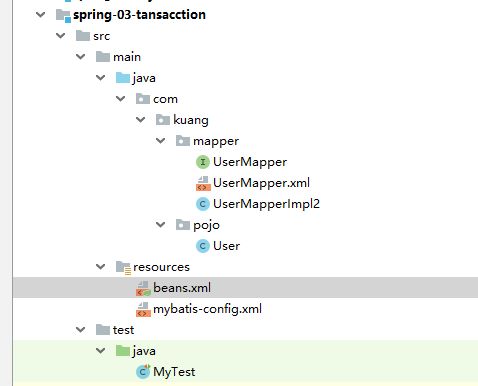10. Spring事务
文章目录
- 回顾事务
- 为什么要有事务?————数据一致性
-
- 1. 事务由来项目结构
- 2. 给UserMapper接口新增两个方法
- 3. 编写UserMapper.xml新增的方法
- 4. 编写实现类UserMapperImpl2
- 5. 进行测试
- Spring中的事务管理
-
- 声明式事务管理
-
- 0. 项目结构:就是【上面的】事务由来的项目
- 1. 使用Spring管理事务,需在beans.xml导入头文件aop,tx
- 2. 事务管理器
- 3. 配置事务的通知
- 4. 配置AOP
- 5. 进行测试
回顾事务
事务就是把一系列的动作当成一个独立的工作单元,这些动作要么全部完成,要么全部不起作用。
事务四个属性ACID原则
原子性(atomicity)
事务是原子性操作,由一系列动作组成,事务的原子性确保动作要么全部完成,要么完全不起作用一致性(consistency)
一旦所有事务动作完成,事务就要被提交。数据和资源处于一种满足业务规则的一致性状态中
-隔离性(isolation)
可能多个事务会同时处理相同的数据,因此每个事务都应该与其他事务隔离开来,防止数据损坏\持久性(durability)
事务一旦完成,无论系统发生什么错误,结果都不会受到影响。通常情况下,事务的结果被写到持久化存储器中
为什么要有事务?————数据一致性
1. 事务由来项目结构
2. 给UserMapper接口新增两个方法
//添加一个用户
int addUser(User user);
//根据id删除用户
int deleteUser(int id);
3. 编写UserMapper.xml新增的方法
我们故意把 delete 写错为deletes,测试!
<insert id="addUser" parameterType="com.kuang.pojo.User">
insert into user (id,name,pwd) values (#{id},#{name},#{pwd})
insert>
<delete id="deleteUser" parameterType="int">
deletes from user where id = #{id}
delete>
4. 编写实现类UserMapperImpl2
public class UserMapperImpl2 extends SqlSessionDaoSupport implements UserMapper {
//增加一些操作
public List<User> selectUser() {
User user = new User(444,"小明","123456");
UserMapper mapper = getSqlSession().getMapper(UserMapper.class);
mapper.addUser(user);
mapper.deleteUser(4);
return mapper.selectUser();
}
//新增
public int addUser(User user) {
UserMapper mapper = getSqlSession().getMapper(UserMapper.class);
return mapper.addUser(user);
}
//删除
public int deleteUser(int id) {
UserMapper mapper = getSqlSession().getMapper(UserMapper.class);
return mapper.deleteUser(id);
}
}
5. 进行测试
@Test
public class MyTest {
@Test
public void test2(){
ApplicationContext context = new ClassPathXmlApplicationContext("beans.xml");
UserMapper mapper = (UserMapper) context.getBean("userMapper");
List<User> user = mapper.selectUser();
System.out.println(user);
}
}
报错:sql异常,delete写错了
结果 :插入成功!
Spring中的事务管理
为什么需要配置事务?
如果不配置,就需要我们手动提交控制事务;事务在项目开发过程非常重要,涉及到数据的一致性的问题,不容马虎!
Spring事务管理分为:
编程式事务管理:java代码
- 将事务管理代码嵌到业务方法中来控制事务的提交和回滚
- 缺点:必须在每个事务操作业务逻辑中包含额外的事务管理代码
声明式事务管理:AOP
- 一般情况下比编程式事务好用。
- 将事务管理代码从业务方法中分离出来,以声明的方式来实现事务管理。
- 将事务管理作为横切关注点,通过aop方法模块化。Spring中通过Spring AOP框架支持声明式事务管理。
声明式事务管理
0. 项目结构:就是【上面的】事务由来的项目
1. 使用Spring管理事务,需在beans.xml导入头文件aop,tx
xmlns:aop="http://www.springframework.org/schema/aop"
http://www.springframework.org/schema/aop
http://www.springframework.org/schema/aop/spring-aop.xsd
xmlns:tx="http://www.springframework.org/schema/tx"
http://www.springframework.org/schema/tx
http://www.springframework.org/schema/tx/spring-tx.xsd
2. 事务管理器
无论使用Spring的哪种事务管理策略(编程式或者声明式)事务管理器都是必须的。
就是 Spring的核心事务管理抽象,管理封装了一组独立于技术的方法。
<bean id="transactionManager" class="org.springframework.jdbc.datasource.DataSourceTransactionManager">
<property name="dataSource" ref="dataSource" />
bean>
3. 配置事务的通知
add的意思是add开头的所有方法?还有所有添加的方法?
propagation="REQUIRED"
propagation是传播的意思
requierd:如果当前没有事务,就新建一个事务,如果已存在一个事务中,加入到这个事务中,这是最常见的选择,也是默认选择。
<tx:advice id="txAdvice" transaction-manager="transactionManager">
<tx:attributes>
<tx:method name="add" propagation="REQUIRED"/>
<tx:method name="delete" propagation="REQUIRED"/>
<tx:method name="update" propagation="REQUIRED"/>
<tx:method name="search*" propagation="REQUIRED"/>
<tx:method name="get" read-only="true"/>
<tx:method name="*" propagation="REQUIRED"/>
tx:attributes>
tx:advice>
4. 配置AOP
记得导入aop的头文件!
<aop:config>
<aop:pointcut id="txPointcut" expression="execution(* com.kuang.dao.*.*(..))"/>
<aop:advisor advice-ref="txAdvice" pointcut-ref="txPointcut"/>
aop:config>
5. 进行测试
删掉刚才插入的数据,再次测试!
@Test
public void test2(){
ApplicationContext context = new ClassPathXmlApplicationContext("beans.xml");
UserMapper mapper = (UserMapper) context.getBean("userDao");
List<User> user = mapper.selectUser();
System.out.println(user);
}
输出结果:





